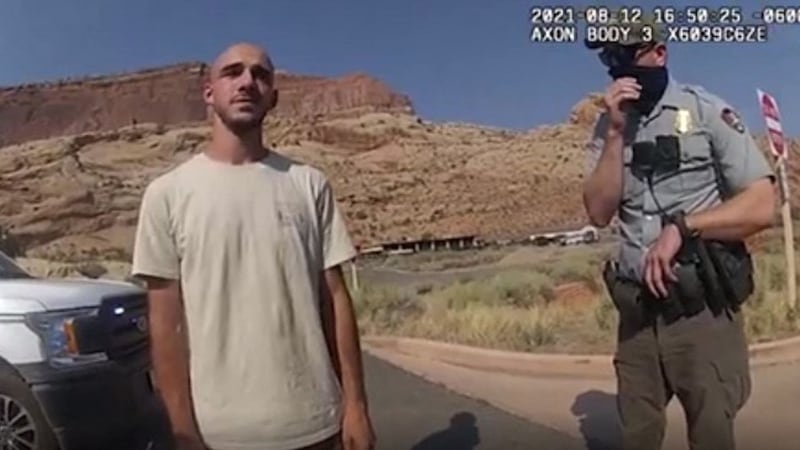Hundreds of thousands of people are reported missing in the United States every year. But it's rare for a single case to capture public attention – and galvanise individuals to take action – as the disappearance of Gabrielle Petito has.
In July the 22-year-old embarked from New York on a cross-country road trip with her fiance, Brian Laundrie, who is 23. As they made their way out west in a white Ford van, the couple posted photos and videos of their journey on Instagram and YouTube. Then, on September 1st, Laundrie returned from the trip alone. Ten days later Petito's family reported her missing.
The case has become a sensation in the US, in large part because of the awareness generated by people who are watching it unfold on social media. Each new development has been followed by flurries of explainer posts and videos from would-be detectives on TikTok, Instagram and Twitter, who have seen their follower counts balloon. Theories have been debated and debunked. And an influencer couple may have helped locate remains that fit the description of Petito.
The couple recalled seeing a white van and combed through their footage to see if it appeared
Paris Campbell, a comedian and writer, took up the case on social media early last week, when interest in the case was nascent. She first read about Petito in the Daily Mail on September 13th but hadn’t seen much about the story on social media.
As a new mother, Campbell, who is 28, was compelled to use her platform (about 150,000 followers on TikTok at the time) to try to reunite Petito’s parents with their daughter.
Her first TikTok about Petito featured a “Missing” poster she’d seen in an article about the young woman’s disappearance. “Screenshot it, share this,” Campbell says in the video. “This girl is actively missing.”
In the days that followed, Campbell posted about 40 videos, including news updates and analyses of Petito’s and Laundrie’s Instagram feeds. One commenter, who identified herself as Petito’s cousin, wrote that the Petito family appreciated the attention she had paid the case and hoped she would continue.
“‘Oh man, her family has seen this,’” Campbell recalls thinking. “‘I want to make sure I’m putting out accurate information and being respectful.’”
Kyle and Jenn Bethune, who have been living in a bus with their three children and four dogs for two years, travelling the United States and making videos for YouTube and Instagram, were also paying attention to the story of Petito and her disappearance.
On Saturday, just before midnight, a friend contacted Jenn Bethune with the information that Petito and Laundrie may have been in Bridger-Teton National Forest, in Wyoming, at the same time as the Bethune family.
Jenn Bethune "jumped out of bed", Kyle Bethune says, and she began reviewing the video she had taken during their time in Wyoming.

The couple recalled seeing a white van and combed through their footage to see if it appeared. “Lo and behold, we saw it, clear as day,” Kyle Bethune says.
Jenn Bethune called the FBI to alert them to their discovery. The person she spoke to directed her to a website to share tips about Petito. They uploaded the video there and also added it to the beginning of a video they had planned to release that morning.
“We know the power of social media,” Kyle Bethune says.
The video went viral, and Jenn Bethune received a request to speak on the phone with Petito's mother, Nichole Schmidt. The two women bonded over shared loss: the day the couple found the video footage showing the van would have been the 17th birthday of Ethan Roeder, Jenn Bethune's son and Kyle Bethune's stepson, who had died in a car accident on a family road trip.
“They had a huge heart-to-heart and mama-to-mama talk,” Kyle Bethune says, “and a good cry.”
She was drawn to Petito because of their similarities – young women, active on social media, engaged to be married – and started posting about her case on TikTok
On Sunday, after a search that involved investigators from the US National Park Service, local authorities and the FBI, human remains that matched Petito's profile were found near the van's location in the video.
Mark Lewis, the writer and director of the Netflix documentary series Don't F**k With Cats, which depicted two amateur detectives who used Facebook and other sites in the 2010s to try to solve a mystery, says that "this idea of internet sleuthing and internet vigilantism" isn't new. "From the safety of your living room, you can do amazing things in terms of detection," he says. "And many, many people are."
Haley Toumaian, a 24-year-old data analyst who lives outside Los Angeles, is one of them. During the pandemic she started recording a true-crime podcast called Inhuman with one of her friends.
She was drawn to Petito because of their similarities – young women, active on social media, engaged to be married – and started posting about her case on TikTok.
With virtually each new development she has updated her followers. When she was in a car on the way to a friend’s wedding this past weekend, police in Florida posted a tweet that included information that debunked a rumour she had mentioned in a TikTok she posted earlier in the day.

Toumaian felt she needed to correct the record by posting a new video immediately. “It’s not aesthetically pleasing,” she says of the video from the car, “but I wanted to get it out there before the wedding, because I wasn’t going to be on the phone during the ceremony.”
In addition to the social-media posts, the case has been covered avidly by many American national news outlets. Petito's name was mentioned dozens of times on CNN on Sunday, the day that the human remains were discovered in Bridger-Teton National Forest. The New York Times published a breaking-news story and a live briefing. Fox News issued multiple news alerts in recent days.
Martin G Reynolds, an executive director of the Maynard Institute for Journalism Education, says he was struck by news outlets' disproportionate attention on missing white women, a focus that he says is compounded by competitive coverage. (At a journalism conference in 2004, the PBS news anchor Gwen Ifill described this phenomenon as "the missing white woman syndrome.")
The demographics of the industry are a big factor, Reynolds says. “Our newsrooms don’t reflect the diversity of the country, and folks in editing roles are even less diverse,” says Reynolds, whose organisation works with journalists of colour. “Until journalism corrects this, we are going to continue to be more and more irrelevant to the audiences that reflect the future.”
We can play the game of, 'Oh it's because she was a vlogger' and all those things, but we can also see that she is a Gen Z, blond, petite girl, and that is what gets the clicks
Online interest in Petito’s case also pushed news editors to closely track her story. “Journalism in general tends to be reactionary, and if we see something blowing up on one of these platforms, we’re going to jump all over it,” Reynolds says.
Alvin Williams, a host of Affirmative Murder, a podcast that focuses on true crimes with black and brown victims, echoed Reynolds' analysis.
“I’m incredibly glad she is getting the resources needed to help find her,” Williams, who is 29, says, talking on Sunday, before law-enforcement officials announce they have recovered a body likely to be Petito’s, “but there is an obvious disproportionate focus on her story,” he says. “We can play the game of, ‘Oh it’s because she was a vlogger’ and all those things, but we can also see that she is a Gen Z, blond, petite girl, and that is what gets the clicks.”
He notes that in Wyoming, the same state where Petito was found, 710 indigenous people went missing between 2011 and 2020, according to a report conducted by the University of Wyoming. “People are selective with the humanity they see in others,” Williams says.
Although she agrees that true-crime storytelling has largely focused on white women, Toumaian sees something different in Petito’s case. “I think people are so into it because it is happening in real time and because you can follow many of the clues yourself that Gabby and Brian left on social media,” she says.
One true-crime podcast, Crime Junkie, rushed to release a special episode on Sunday about the Petito case. "This isn't a regularly scheduled episode," the host, Ashley Flowers, told listeners, explaining that the show was focused for "the first time ever" on "a breaking story".
“In almost four years of doing this show I have never, I mean never, seen you guys in a frenzy like you are in now,” she said. “Our emails are flooded. Our DMs are flooded.”
On Monday the episode was the fifth most popular on Spotify's podcast charts and No 1 on Apple Podcasts. – This article originally appeared in The New York Times











